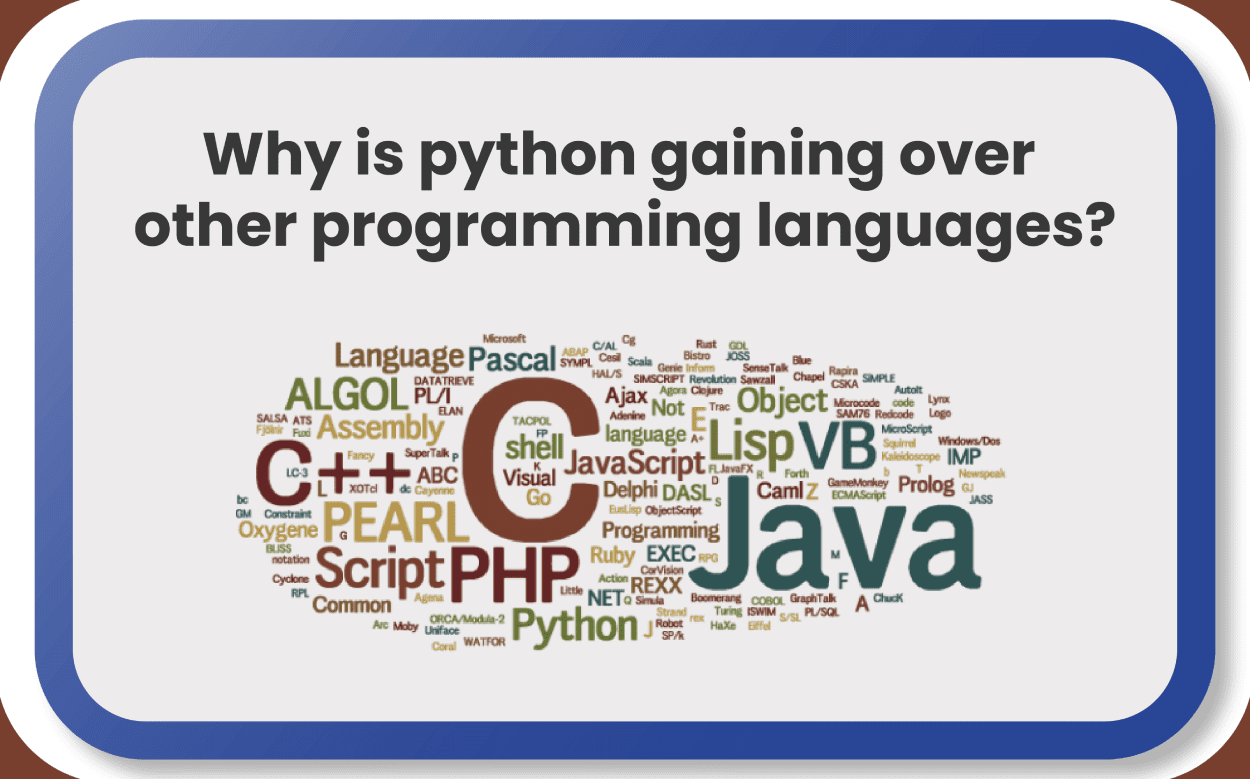Why Is Python Gaining Over Other Programming Languages?

What is the Python programming language? Python is one of the most popular dynamic programming languages used today. Dutchman Guido van Possum developed Python and released it in 1991. Python is an open-source and object-oriented programming language. Google, Quora, Mozilla, IBM, and Cisco use Python due to its simplicity. The early development of Python began at a research institute in the Netherlands. The goal was to create a high-level language to bridge the gap between C and Shell. Building system administration utilities using C was rather complicated back at that time. Languages like Algol68, Pascal, and ABC motivated the syntax of Python. This made the syntax more readable and clear. Python became popular due to the ease of writing code. But, the real popularity of Python comes from its features. Python has a wide range of features and application scope to attract developers.
Let’s Now See Which Features Make Python So Popular.
1. Elegant And Simple To Understand Syntax
Python has some similarities to the English language with influence from mathematics. Python allows developers to write programs with fewer lines than other programming languages. Python uses new lines to complete a command instead of semicolons or parentheses. Python relies on indentation to define scopes, such as loops, functions, and classes. Other programming languages often use curly brackets for this purpose.
2. Large Standard Libraries
Python’s standard library is very extensive, offering a wide range of facilities. These libraries contain modules written in both C and Python. There are many built-in functionalities available in these libraries. It can help do various tasks involving regex, documentation, unit testing, threading, DB, web browsers, XML, HTML, WAV files, cryptography, GUI, and many more. These functions help developers complete tasks with ease and less amount of code.
3. Free
It is free software in a couple of categories. It does not cost anything to use or download Pythons or to add it to the application. It can also be redistributable and modifiable without any cost. Python is righted available under an open-source license. This allows developers to create and distribute applications at a reasonable cost.
4. Code Anywhere
It is possible to program and execute Python code on various OS platforms. Python is compatible with many Operating Systems such as Linux, Windows, Mac, Solaris, and many more. This allows developers to work on any OS without restrictions.
5. Embed
Python programming language is embeddable. Developers can use Python within the C/C++ program to give scripting capabilities to the program’s users.
Now Let’s See The Current Applications Of Python
- Many Linux distributions use installers written in Python. In Ubuntu, we have the Ubiquity.
- Python has extensive use in the information security industry, including in exploit development.
- Raspberry Pi– a single-board computer that uses Python as its principal user-programming language.
- Python is now being used in Game Development areas also.
- Python is embedded in several software products as a scripting language.
- GNU debugger uses Python as a pretty printer to show complex structures such as C++ containers.
- Python is also used in artificial intelligence and ML.
- Python is often used for natural language processing tasks.
Conclusion
This gives us a good idea of how important Python is today. This also states the reason behind the popularity of Python among developers. Our world is stepping towards a new era of technology enhancement. This increases the demand for candidates with effective programming knowledge to develop applications. Having Python training can be one of the ideal ways to take part in this developing IT industry. So what are you waiting for? Take your first Python demo at IIHT Surat today. And learn Python programming language from the best and most experienced trainers in Surat.
Read Also: Learn Python in 2023 and Become an Expert Through its Effective Approach

We are a leading Surat-based International IT Education & Training Institute that offers 65+ industry-specific Software & Hardware Networking Placement Courses where qualified industry professionals guide you in your chosen certification course.
Our IIHT Branches are located at Adajan & Ringroad. Visit IIHT Surat to get expert assistance from our well-skilled counsellors for your academic excellence. Demo Classes & Easy EMI Options are available.
Trending Courses
© Copyright 2023 IIHT Surat. All rights reserved.